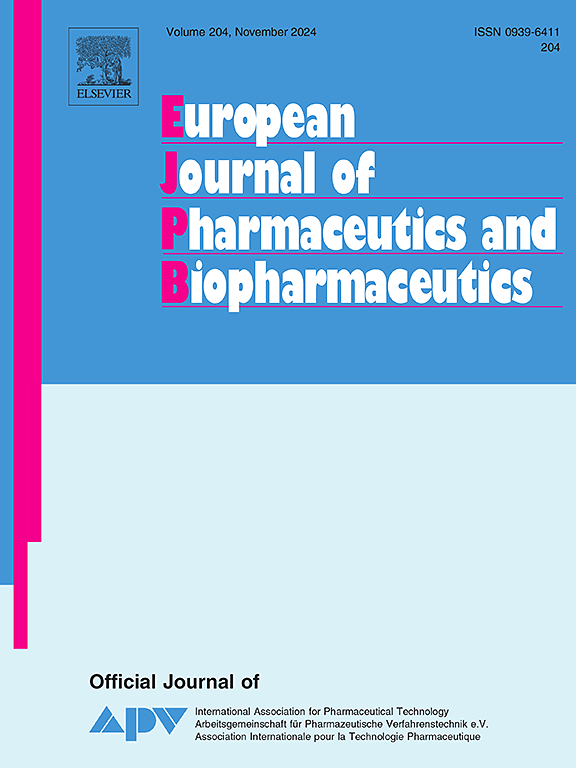Navigating through chemometrics: Unveiling antibiotic-food interactions for improved pediatric formulations ahead
IF 4.4
2区 医学
Q1 PHARMACOLOGY & PHARMACY
European Journal of Pharmaceutics and Biopharmaceutics
Pub Date : 2025-01-26
DOI:10.1016/j.ejpb.2025.114652
引用次数: 0
Abstract
Background
Given the challenges of pediatric antibacterial therapy, it is crucial to formulate antibiotics with a lower potential for interaction with dietary interventions and tailor them for optimal administration in children. Chemometric methods allow us to analyze multiple interrelated variables simultaneously and uncover correlations.
Aim
We applied a chemometric approach to examine how food, beverages, antacids, and mineral supplements affect antibiotic bioavailability in adults and children, aiming to explore relationships between antibiotic structure, physicochemical properties, and post-meal changes in pharmacokinetic (PK) parameters.
Methods
We selected 95 antibacterial drugs for analysis, including beta-lactams (32), quinolones (25), macrolides (13), tetracyclines (16), and others (9). The input dataset comprised information from published clinical trials, chemical records, and calculations. We constructed hierarchical partial least squares (PLS) models with changes in PK parameters (ΔAUC, ΔCmax, ΔTmax, and Δ t ½) as response parameters and nine groups of molecular descriptors (M1-M9) as predictor parameters. We performed analyses separately in children and adults for different dietary interventions.
Results
In the final 10 PLS models, significant components explained 61–90% and 10.3–54.4% of the variance in the predictor and response parameter sets, respectively. We obtained 59 significant positive and negative correlations between antibiotic structure or physicochemical properties (molecular descriptors) and action in the human body in the presence of food, antacids, or mineral supplements (changes in PK parameters), of which 41 concern pediatric patients.
Conclusions
Chemometric methods can be helpful and valuable in investigating the interactions between antibiotics and dietary interventions. Using chemometrics may pave the way for formulating antibiotics for children with a lower potential to interact with food.

通过化学计量学导航:揭示抗生素-食物相互作用,以改善儿科配方。
背景:鉴于儿童抗菌治疗的挑战,制定与饮食干预相互作用可能性较低的抗生素并根据儿童的最佳给药是至关重要的。化学计量学方法允许我们同时分析多个相互关联的变量并揭示相关性。目的:我们采用化学计量学方法研究食品、饮料、抗酸剂和矿物质补充剂如何影响成人和儿童的抗生素生物利用度,旨在探索抗生素结构、理化性质和餐后药代动力学(PK)参数变化之间的关系。方法:我们选择了95种抗菌药物进行分析,包括β -内酰胺类药物(32种)、喹诺酮类药物(25种)、大环内酯类药物(13种)、四环素类药物(16种)和其他药物(9种)。输入数据集包括已发表的临床试验、化学记录和计算的信息。我们构建了分层偏最小二乘(PLS)模型,以PK参数(ΔAUC, ΔCmax, ΔTmax和Δ t1 / 2)的变化作为响应参数,九组分子描述符(M1-M9)作为预测参数。我们分别对儿童和成人进行了不同饮食干预的分析。结果:在最终的10个PLS模型中,显著成分分别解释了预测参数集和响应参数集方差的61-90%和10.3-54.4%。我们获得了59项抗生素结构或理化性质(分子描述符)与食物、抗酸剂或矿物质补充剂存在时在人体内的作用(PK参数的变化)之间的显著正相关和负相关,其中41项涉及儿科患者。结论:化学计量学方法有助于研究抗生素与饮食干预之间的相互作用。使用化学计量学可能为那些与食物相互作用可能性较低的儿童制定抗生素铺平道路。
本文章由计算机程序翻译,如有差异,请以英文原文为准。
求助全文
约1分钟内获得全文
求助全文
来源期刊
CiteScore
8.80
自引率
4.10%
发文量
211
审稿时长
36 days
期刊介绍:
The European Journal of Pharmaceutics and Biopharmaceutics provides a medium for the publication of novel, innovative and hypothesis-driven research from the areas of Pharmaceutics and Biopharmaceutics.
Topics covered include for example:
Design and development of drug delivery systems for pharmaceuticals and biopharmaceuticals (small molecules, proteins, nucleic acids)
Aspects of manufacturing process design
Biomedical aspects of drug product design
Strategies and formulations for controlled drug transport across biological barriers
Physicochemical aspects of drug product development
Novel excipients for drug product design
Drug delivery and controlled release systems for systemic and local applications
Nanomaterials for therapeutic and diagnostic purposes
Advanced therapy medicinal products
Medical devices supporting a distinct pharmacological effect.

 求助内容:
求助内容: 应助结果提醒方式:
应助结果提醒方式:


